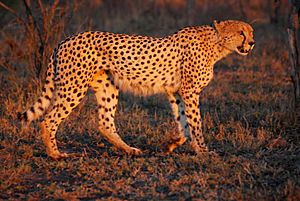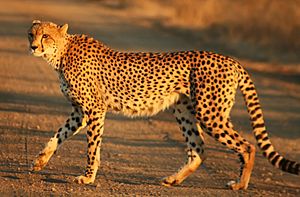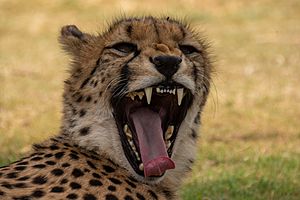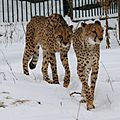Southeast African cheetah facts for kids
Quick facts for kids South African Cheetah |
|
|---|---|
 |
|
| A South African Cheetah from Hluhluwe-Umfolozi Game Reserve, South Africa. | |
| Conservation status | |
| Scientific classification | |
| Kingdom: | |
| Phylum: | |
| Class: | |
| Order: | |
| Family: | |
| Genus: | |
| Species: | |
| Subspecies: |
A. j. jubatus
|
| Trinomial name | |
| Acinonyx jubatus jubatus (Schreber, 1775)
|
|
 |
|
| A. j. jubatus range (blue) | |
| Synonyms | |
|
Acinonyx jubatus lanea |
|
The South African Cheetah (Acinonyx jubatus jubatus) is also called the Namibian Cheetah. It is a type of cheetah that lives in Southern Africa. This cheetah is the most common kind, with over 6,000 living in the wild.
Since 1990, the number of cheetahs in Namibia has grown a lot. In 2015, there were more than 3,500 cheetahs there. The South African Cheetah is closely related to the Asiatic Cheetah and the Northeast African Cheetah.
What Does a South African Cheetah Look Like?
The cheetah is a medium-sized cat. An adult male cheetah can be about 168 to 200 centimeters (66 to 79 inches) long. Females are a bit smaller, measuring 162 to 213 centimeters (64 to 84 inches).
Adult cheetahs stand about 70 to 90 centimeters (28 to 35 inches) tall at the shoulder. Males are usually a little taller than females. They also have slightly bigger heads.
Wild cheetahs in Namibia have been measured. Females are about 113 to 140 centimeters (44 to 55 inches) long, not including their tails. Their tails are about 59.5 to 73.0 centimeters (23.4 to 28.7 inches) long. They weigh between 21.0 and 63.0 kilograms (46.3 and 138.9 pounds).
Males are about 113 to 136 centimeters (44 to 54 inches) long, not including their tails. Their tails are about 60 to 84 centimeters (24 to 33 inches) long. They weigh between 28.5 and 65.0 kilograms (62.8 and 143.3 pounds).
The cheetah has a bright yellow or golden coat. Its fur is a bit thicker than other cheetah types. Its white belly is very clear, especially on its neck and chest. It has fewer spots on its belly.
The spots on its face are very noticeable. Overall, its spots seem closer together than on most other cheetahs. The "tear marks" from its eyes are thicker near the mouth. Almost all of them have clear brown mustache marks. Like the Asiatic cheetah, it can have fur behind its tail. Its tail can have both white and black tips, or sometimes just a black tip.
In desert areas, like the Kalahari, cheetahs are usually smaller and lighter. They have thinner, brighter fur. The Northwest African cheetah also has this feature.
Images for kids
-
An illustration of a cheetah cub (Acinonyx jubatus guttata) by Joseph Wolf in the Proceedings of the Zoological Society of London, 1867
-
The Southeast African cheetah was one of the most widespread animals. These two cheetahs were photographed at southwestern South Africa between 1906 and 1918.
-
A cheetah suffocating an impala in Timbavati, South Africa
-
An orphan cheetah set to be reintroduced to Victoria Falls, Zimbabwe
-
Two captive cheetahs in Nehru Zoological Park, India. The Asiatic cheetah, which used to inhabit India, is extinct there.
-
A cheetah in Cincinnati Zoo and Botanical Garden, Ohio, the United States of America
-
Cheetahs and other captive animals are able to live in cold climate, as demonstrated by these cheetahs at Tiergarten Schönbrunn, Austria
-
A cheetah silhouetted against a fiery sunset in Okavango Delta, Botswana
-
At Farm Achalm in Namibia
See also
 In Spanish: Guepardo sudafricano para niños
In Spanish: Guepardo sudafricano para niños

















